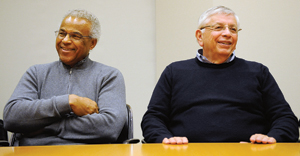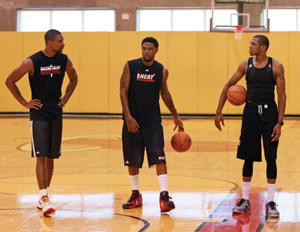Three weeks removed from predictions of a “nuclear winter” for pro basketball and dueling lawsuits between the league and its players, the NBA is implementing local outreach efforts and unveiling two new advertising campaigns in hopes of winning back any fans discouraged by the five-month lockout.
Details were still being finalized late last week, but the teams’ initiatives are slated to begin with Friday’s expected opening of training camps. Nationally, the crux of the effort is a new leaguewide ad campaign dubbed “Big Things Are Coming” that will run across all NBA broadcast and social media platforms. Teams also will activate around the campaign, as the league tries to spark interest in a 2011-12 season slated to tip off, as of last week, on Christmas Day, with five nationally televised games.
Teams also are expected to hold open practices and free scrimmages in the wake of
the tentative resolution to a labor fight that wiped out the first two months of the NBA’s regularly scheduled season.
The “Big Things” campaign was expected to begin last Friday and run through the first two weeks of the season. The league plans to follow that with a second new campaign. That still-to-be finalized effort is expected to replace the league’s “Where Amazing Happens” campaign used in recent years.
 |
With smiles from dealmakers and players back on the practice courts, the league is starting up its “Big Things” campaign, which it expects to run through the season’s first two weeks.
Photos by: AP IMAGES (TOP); GETTY IMAGES
|
Goodby, Silverstein & Partners is the NBA’s agency of record.
“We have [lockout] history on our side and we know what has worked,” said Danny Meiseles, executive vice president and executive producer, production, programming and broadcasting for the NBA. “The ‘Big Things Are Coming’ campaign evolved into the start of the season. … There also will be fan events and game-related events.”
In 1999, when the league worked to come back from a lockout that cost it the start of its originally scheduled 1998-99 season, teams held open practices and team events in hopes of reigniting fan interest. Ultimately, for the 50-game season that started in February, average attendance was down 2 percent from 1997-98, Michael Jordan’s final season in Chicago.
With the NBA now similarly poised for a shortened, lockout-induced 66-game schedule following a boom season for the league, NBA Commissioner David Stern told SportsBusiness Journal last week that the regular-season tipoff on Christmas Day will serve as a barometer for any damage inflicted by the year’s labor strife.
“It’s hard to know about [how the lockout has affected fan interest] before Christmas,” Stern said. “Let’s see what that day looks like. Fans connect by coming to our games and watching them on television, and buying our products.”
For the past five months, what fans saw was animosity and discord between the league and players, with comments from both sides being particularly visible in today’s era of Twitter and social media. Miami star Dwyane Wade tweeted in October, “STERN’s ‘WORDS’ 2day hurt the ppl who work at the AAA, other arenas, as well as local businesses & our fans.” He later posted, “Those are the ones who are affected by STERN’s ‘WORDS’ 2day...It’s a Lockout — NOT a Strike.”
Stern, more recently, referred to the union taking the labor fight to court as the beginning of a “nuclear winter” for the NBA. That followed the league issuing what became cast as a “take it or leave it” ultimatum to the players, while union outside counsel Jeffrey Kessler accused owners of treating players “like plantation workers,” a comment for which he later publicly apologized.
Highlights of tentative new NBA labor deal
■ The players’ share of basketball-related income is no less than 49 percent and no greater than 51 percent. Players’ BRI share is down from 57 percent under the expired collective-bargaining agreement.
■ The soft salary cap system remains in place, as under the previous CBA. During the deal’s first two years, tax rate on teams is $1 for every $1 spent over the cap, the same as in the previous CBA, but the new deal includes incremental tax increases beginning in year three of the 10-year deal, ranging from $1.50 to $3.25 for every dollar spent above the salary cap.
■ The new deal decreases the maximum annual salary increase for “Bird” exception free agents to 7.5 percent, down from 10.5 percent in previous CBA. The non-Bird annual free agent salary increase is 4.5 percent, down from the old CBA’s 8 percent allowance.
■ Contract lengths are shortened, from a six-year maximum to a five-year maximum for players re-signing with their teams and to four years for other free agent contracts.
■ Midlevel exception of up to $5 million starting salary with four-year maximum contract length for teams that don’t exceed the luxury tax threshold by more than $4 million. The midlevel salary exception during the last year of the prior CBA was $5.7 million for a five-year maximum length.
■ No reduction in rookie scale or minimum salaries.
■ Extend-and-trade contracts will continue to be permitted, but with adjustments in contract lengths.
— Compiled by John Lombardo
“I suspect that if there are any lingering bad feelings between [the two sides] they will dissipate quickly,” said Ed Horne, chief operating officer of Madison Avenue Sports and Entertainment and formerly an executive with the NHL during its 2004-05 lockout.
The challenge for both sides, upon formalizing the new collective-bargaining agreement, is to jointly appeal to fans. Late last week, the players were working to re-form their union in order to vote on the new labor deal. Owners must also ratify the deal, but the expectation was that the new CBA would be in place in time for training camps to open and free agency to begin on Friday.
“A relatively sophisticated marketer wrote me a note,” Stern said, “and it said, ‘People have not missed you yet, so opening on Christmas Day with so many games should be a bonanza.’ But the very early indications in areas like online buying, brick and mortar buying at our store, sponsors planning activation, and advertising sales by our network rights holders [for our sponsors] are all exceeding expectations.”
NBA Deputy Commissioner Adam Silver said that getting a labor deal done by Christmas will help regain the momentum lost after last year’s blockbuster season that delivered records in both television viewership and full-season-ticket sales.
“I don’t think we ever went past the point of no return in terms of fan interest and avidity,” Silver said. “Christmas Day was the marker, and we are meeting that. Humbled as we should be, we think our fans will come right back. On the business side, our partners were all very supportive, and to them as well, I think it was important to return on Christmas Day. So I think we will have not lost a beat. I really think we will bounce right back.”
The NBA’s fan-engagement efforts began over Thanksgiving weekend, almost immediately upon word of a tentative new labor deal being reached. Some teams sent letters to their season-ticket holders informing them of the pending end of the lockout and pledging outreach plans.
Last week, both teams and arena managers were busy compensating suite holders, their highest-paying customers. While terms vary by team and market, clubs and buildings in general are providing cash rebates or hospitality credits for future games.
Air Canada Centre in Toronto lost 17 games during the lockout. The arena’s 142 suite holders have deals tied to a formula that guarantees them 135 events over the course of the season, equally distributed among NBA and NHL games and special events. For every arena date lost over that total, suite holders receive a “go forward” credit, said Bob Hunter, Air Canada Centre’s executive vice president of venues and entertainment and the building’s general manager.
TD Garden in Boston, by comparison, does not guarantee suite holders a minimum number of events. Instead, Delaware North Cos., the arena’s owner/operator, provides options that include corporate use of the event floor on dark days. Those activities are branded as “Play on Parquet” and “Slice the Ice,” said Amy Latimer, TD Garden’s senior vice president of sales and marketing.
Staples Center in Los Angeles took the biggest hit over the lockout. The home of the Clippers and Lakers lost 24 regular-season games and five preseason dates. AEG, the arena’s owner/operator, guarantees suite holders 150 events annually. As of last Thursday, AEG officials were still working out the details for compensating those premium patrons, said Lee Zeidman, Staples Center’s senior vice president and general manager.
Staff writers Terry Lefton, Don Muret and Kristen Heimstead contributed to this report.





